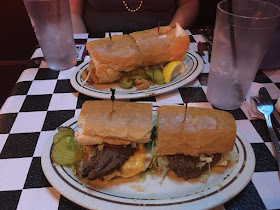Since I recently traveled to New Orleans for a social sciences conference, I would like to share some of my photographs and the history of Louisiana's renowned port city. New Orleans was established by the French Mississippi Company in May 1718. The colony, named after Philippe II, Duke of Orleans, faced numerous struggles with the Natives in Southern Louisiana, yet emerged as a powerful shipping city at the start of the nineteenth century, famous for its smuggling. New Orleans and the Louisiana Territory was transferred to the Spanish after the American Revolution, then back to the French's hands, before being acquired by the United States in 1803. An influx of American east-coast civilians, Europeans, and Haitian refugees settled in the city after the Louisiana Purchase. By the early 1810s, a majority of the city's population was black; between 1808 and 1865, more than 2 million African slaves were forcibly displayed at auctions in New Orleans. The plot of land that the city's Omni Hotel currently sits on used to be the home of New Orleans's largest slave pen, which operated six days a week. Slave traders who resided in New Orleans included Hope Hull Slatter, John Hagan, and Joseph Bruin. Solomon Northup, the freeman who was cruelly coerced into slavery for 12 years, was sold at Theophilus Freeman's slave pen in New Orleans. Owing to slavery and cotton, New Orleans's wealth steadily grew.
Following the Civil War and elimination of slavery, New Orleans, like most of the American South, played host to several violent riots and racial lynchings. At the turn of the twentieth century, the city's population and once-great national importance diminished since the growth of railroads and highways took over the once-used river travel, and thousands of colored folks migrated to California and the West. By the 1950s, New Orleans was no longer the leading urban area in the South, with Houston, Dallas, and Atlanta eclipsing its trading records. Towards the end of the twentieth century, the city built its industry on tourist attractions, most notably Bourbon Street (with its world-famous bars, strip clubs, and nightlife entertainment). Unfortunately, most of New Orleans was destroyed by Hurricane Katrina in August 2005. Labeled as "the worst engineering disaster in the world since Chernobyl," the flooding of this brilliant city devastated Louisiana's landscape. The hurricane's storm surge overpowered the city levees, permitting tons of water to swarm the streets. People were killed, electricity was out, and homes were destroyed. Thousands evacuated to surrounding areas and seeked help from temporary Red Cross shelters, including in Dallas (my mum volunteered at a shelter during the Katrina crisis). Federal, state, and local institutions helped the city civilians rebuild New Orleans after Hurricane Katrina. Slowly, the infrastructure was reconstructed and New Orleans again became the vibrant city we all know and love. I am incredibly grateful to have participated in the SSSA conference and visit such a colorful and magnificent city like New Orleans.
 |
| One of the highlights of the trip was a lunch at Ruby Slipper Café, where I had eggs benedict with Applewood smoked bacon for the first time. It was delicious! |










No comments:
Post a Comment